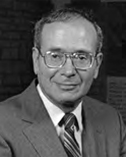
 Frank Press
Frank Press
1981-1993 NAS President
Philip Handler's successor, Frank Press (1924–2020), a geophysicist, was also a New Yorker. He was elected president of the Academy in 1981 and served for a full twelve years. He had also received his undergraduate education at what was then the City College of New York and had completed graduate work in geophysics at Columbia University in 1949. He remained at Columbia University in junior faculty positions until 1955 when he received a professorship at the California Institute of Technology, along with the directorship of the Seismology Laboratory of the Institute. In 1965 he was appointed professor of geophysics and chairman of the department of earth and planetary sciences at the Massachusetts Institute of Technology. This appointment was interrupted by a call to Washington, D. C., in 1977. There he served an eventful four year term as science advisor to President Jimmy Carter and director of the Office of Science and Technology Policy in the Executive Offices of the White House. He was elected president of the Academy soon after returning to Cambridge at the end of the Carter administration with the result that he reversed his steps, back to Washington.
Frank Press' career is a highly distinguished one on many counts. At the scientific base, he belonged to the first generation of geophysicists who benefited from and contributed to the magnificent revolutionary developments associated with the evolution of the field of plate tectonics, briefly described earlier in this document. He became one of the leaders in this area of research and received appropriate recognition both domestically and abroad. For example, he was awarded the gold medal of the Royal Astronomical Society in 1972 and the U. S. National Medal of Science in 1994. Similar recognition for his scientific achievements was provided by France, Germany, Japan and Russia over the years. More specifically, he was one of the two individuals awarded the Japan Prize in 1993. The prize is regarded to be at the same level as the Nobel Prize in the fields it recognizes and is presented in person by the Emperor.
On retiring at the age of 69 in 1993 from a very active period of leadership in the Academy, he decided not to return to an academic position at a university, as might have been feasible, but to accept a four year appointment (1993–1997) as the Cecil and Ida Green Research fellow at the Carnegie Institution in Washington. This left him with much freedom for action. He did, however, establish formal links that were partly, but by no means entirely, honorific, with Columbia University, the California Institute of Technology and the Massachusetts Institute of Technology.
In his new role, Press soon found himself called upon as a wise and highly informed advisor by many organizations, both public and private. The magnitude and diversity of the overall requests turned out to be sufficiently great that it proved desirable not only to join with others in formulating responses, but to create at least one flexible institution with a formal business structure.
The innumerable effective forms of leadership that Press has displayed over the years from his bases in Washington, and in his quiet and reserved manner, stand up well when compared with those of Joseph Henry and Charles Walcott. In the year 2000 he was designated “President Emeritus of the National Academy of Sciences”, apparently the first time the title was granted. It is however one that Detlev Bronk would have appreciated possessing in his later years. The latter retained a working office at the Academy as well as at The Rockefeller University until his death.
Continue reading next chapter: Bruce Michael Alberts

